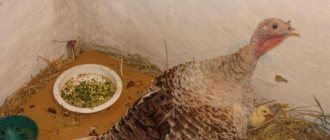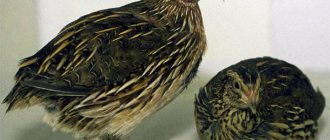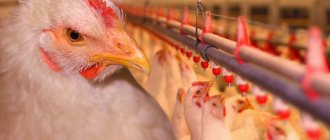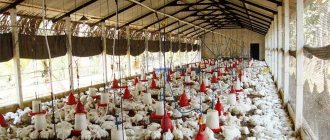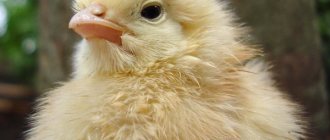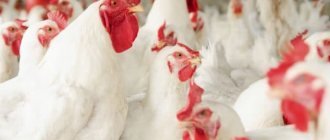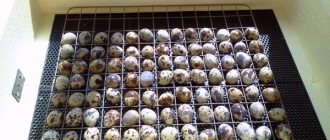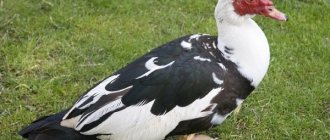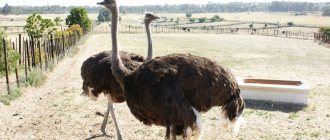Breeding quails for sale is a promising and fairly easy to implement direction. To earn a normal income, you need to use a livestock of 600 or more, but if you follow the growing rules, you will increase it up to 10 times in a year.
In order for the growth rates and, accordingly, profits to be maximum at minimum costs, it is necessary to exclude all possible surprises - low-quality feed, diseases, lack of equipment, etc. Be sure to select the right equipment, consider the heating and lighting system, create high-quality ventilation and eliminate drafts. Read about ventilation in a chicken coop at this link.
Quails can be bred both in the countryside on a farm and at home in an apartment.
Quails grow best at a temperature of 20 degrees and a humidity of no more than 70%.
Profitability of quail business
The production and sale of products is perhaps the most filled niche in agriculture. To earn good money, you need to choose the least competitive one, taking into account the specifics of your region of residence.
Not many farms are involved in quail breeding, so this area is considered one of the most promising.
The main value of quails is their eggs, which are healthy, dietary, and do not contain harmful cholesterol. Only the beak and paws are not used in industry - all other parts of the birds are used. Eggs can be used for food without restrictions, including for allergy sufferers. Meat is a dietary product rich in vitamins that normalizes the functioning of the gastrointestinal tract. The feathers can be used to stuff pillows, and the droppings can be used as organic fertilizer. Even ground poultry bones are used on the farm as feed for other birds.
A quail farm with a population of 500 can pay for itself in just two months.
What is better to produce: meat or eggs?
The good thing about quail business is that the production is virtually waste-free: you can sell both meat and eggs. Which is better to choose? It is better to choose right away, since there are two subspecies of birds: meat and egg.
- Quails of meat breeds, with proper care and feeding, gain 300-330 grams. (normal slaughter weight) in less than 3 months. They lay few eggs. However, such birds are more demanding of care. When raising meat birds, you will have to devote a lot of time to care.
- After the first month of life, the quail begins to actively lay eggs; the average productivity of 1 laying hen is 23-25 eggs/month. In this mode, they bear fruit for 10-12 months, after which they age.
When organizing a farm, it is recommended to choose both directions. This way you can increase revenue and speed up the break-even point.
Advantages of quails over chickens
Quail eggs and meat are much healthier than chicken eggs - and these advantages should be used when promoting products.
The composition of quail eggs is much richer. They contain (compared to chicken):
- potassium (5 times more);
- iron (4.5 times more);
- vitamins B1 and B2 (2.5 times more);
- vitamins A, B1, B2, P, K, iron, phosphorus, cobalt;
- several amino acids.
Quail meat is a delicacy: it is more tender, juicier, and more aromatic than chicken. From the point of view of chemical composition there is also a difference. In him:
- more proteins, vitamins and microelements;
- less fat;
- contains a large amount of fatty acids (polyunsaturated).
The health benefits of consumption have long been known. Meat has immunomodulatory properties, improves the condition of internal organs and strengthens bones.
And, of course, quail meat is much tastier than chicken and rabbit meat.
How much money do you need for a quail farm?
The financial costs of opening a quail farm based on the purchase of 500 birds are:
- Purchase of quail stock – 3000 rubles.
- Purchase of feed – 5000 rubles.
- Equipment (cage batteries, incubator, feather removal device) – 80,000 rubles.
- Heating and lighting of the room - 3000 rubles.
In total, we get the amount of 91,000 rubles. The payback period will be approximately 6 months. The calculation was made without taking into account the cost of processing documents and certificates - 67,000 rubles.
Expected monthly profit
| Index | On feed | At its stern |
| Number of males | 125 | 125 |
| Number of females | 500 | 500 |
| Total number of eggs | 9750 | 9750 |
| Eggs to put in the incubator | 1964 | 1964 |
| Eggs for sale | 7786 | 7786 |
| Carcasses for sale | 1375 | 1375 |
| Average carcass weight, g | 250 | 250 |
| Farm income, rub. | 185830 | 185830 |
| Feed costs, rub. | 21600 | 10800 |
| Current expenses, rub. | 87800 | 87800 |
| Net profit, rub. | 76430 | 87230 |
The cost of meat, according to market indicators, is taken to be 450 rubles per kilogram, eggs - 40 rubles per dozen. At this price level and availability of sales, growing quails as a business will pay for itself in 5 months.
Detailed recommendations for opening a quail business
As already noted, it is more profitable to work with already adult individuals, but you can also start breeding quails with chicks, which will need to be raised from hatching eggs. The hatchability rate of eggs using an incubator is about 75%.
If you purchase 200 eggs, then an average of 150-160 individuals should hatch from them, then approximately 140 birds from this number will survive. In the first year, one bird produces 280-300 eggs, then activity decreases.
Caring for the young
Growing chicks are kept in brooder boxes. You can make them yourself from plywood. An important condition for raising chicks is maintaining temperature and light conditions. Quails are seated separately from adults under constant light sources at a temperature of about 28°C. Gradually, from the 7th day of life, illumination and temperature are reduced. When the chicks reach 3 weeks of age, they must get used to a temperature of 22°C and adapt to a daylight hours of 17-18 hours.
Stages of building a business
Breeding quails at home for beginners:
- Writing a business plan.
- Choosing a room.
- Equipment installation.
- Purchase of livestock.
- Passing certification.
- Determination of sales markets.
Concept development
At first you can grow about 500 pieces. If you use your young animals to replenish the livestock, then in a year you can increase it to five thousand. It is realistic to keep 1 thousand quails on a farm.
Sell:
- carcasses;
- eggs for food and incubation;
- young animals: one-, two-week or month old.
Priorities are determined: sale of eggs, meat or young animals. The conditions of detention depend on this.
They decide how to breed livestock, whether it is profitable or not to raise them from eggs, or whether it is better to purchase adults. In the first case, the process will take time. There is no guarantee that the chicks will be of the exact breed that is offered.
Required documents
Like any business, quail breeding requires certain paperwork.
First of all, you need to register as an individual entrepreneur and obtain permission to open your business.
Secondly, it is necessary to obtain permission for sale from the veterinary service. It is given after passing a product test in the laboratory. You can obtain documents from the department of the Federal Service for Veterinary and Phytosanitary Control.
Before certifying products, read the guide “Technologies for keeping quails on farms”, developed by the All-Russian Research and Technological Institute of Poultry Farming in 2006.
Thirdly, when supplying goods to supermarkets, you may need to enter into an agreement with the owner of a restaurant or chain.
Business plan for quail breeding
Calculations for opening a quail business for 600 individuals will be approximately as follows:
- Rented premises area 20 sq.m. 12–15 thousand rubles (this expense item is removed if you have your own premises in the household plot);
- Purchase of young quails 20–25 thousand;
- Purchase of equipment (cages, incubator, brooder) 30 thousand rubles;
- Feed costs are 3–5 thousand rubles.
The starting capital that will be required at the initial stage will be 65–75 thousand rubles.
Monthly expenses for maintaining a household consist of utilities, transportation of finished products, and purchases of feed. The average amount of fixed costs is about 15,000 rubles.
See also: How to open an quest room in your city? Business plan for an quest room with calculations of how much it costs
Profitability will help determine whether it is profitable to keep a quail farm. To correctly assess profitability, it is necessary to divide the revenue into three options for selling products: eggs, meat, live poultry.
Businessvsele.ru website recommends a few more business ideas:
- Breeding broilers for meat;
- Organization of a duck farm;
- How to raise geese for meat.
Let's consider another version of the quail breeding plan.
Expenses
- Equipment of the premises (construction from scratch) – 60 – 80 thousand rubles.
- Purchase of equipment (cages, drinking bowls, feeders) – 20 – 25 thousand rubles.
- Purchase of an incubator – 6 thousand rubles.
- Purchase of feed (1 ton) – 15 thousand rubles.
- Buying 100 quails – 10 thousand rubles.
- Registration of documents – 5 thousand rubles.
- Advertising (per month) – 500 rub.
- Lighting and heating (10 sq. m. per month) – 2 thousand rubles.
- Transport costs – 3 thousand rubles.
These are far from accurate calculations. You can spend much less money on equipment and space if you do everything by hand or if you already have a ready-made shed. Incubators can also be made by hand.
Costs for transportation, advertising and heating may also vary depending on the time of year and whether you own a vehicle.
Income
- Sale of eggs (based on 100 laying hens, at a price of 20 rubles per dozen) – 6 thousand per month.
- Sale of quail carcasses - 50 - 100 rubles per carcass.
- Sale of litter - about 2 thousand rubles per month.
Depending on the region, the price may vary slightly. Therefore, we recommend that you familiarize yourself with the prices in your region and, if necessary, make adjustments to the business plan we propose.
We recommend that you raise about 1000 quails - one family can easily cope with this number of birds. To organize a business, you will need an equipped room, drinking bowls, feeders, cages, an incubator, brooder, feed and bedding.
Send quail droppings to a compost pit or put them in barrels for further removal.
When planning a business to organize a quail farm, you should take into account a number of issues related to the placement of birds, their care and feeding, maintaining the efficiency of the livestock and distribution channels for products. If you decide to also work with hatching eggs, you will need a chicken or quail incubator, since quails have lost the ability to reproduce independently at home.
At the same time, hatching eggs are purchased from quail farms and transported very carefully, otherwise many eggs simply will not hatch into chicks. Chicks are very sensitive to food, and the same option as for adult birds will not work for them. After purchasing, the chicks are immediately placed in cages that are already prepared and have food and water.
Market analysis
In a business plan for creating a quail farm, it is necessary to analyze competition for enterprises similar in scale of production. There are large quail farms - with populations of 50 thousand birds, medium ones - from 1000 thousand and small ones - up to 1000 thousand. Therefore, it would be natural to analyze small and medium-sized enterprises that have already successfully occupied their niche.
It is important to note all their disadvantages and advantages regarding business organization, product presentation on the market and sales channels. It is worth working on finding the most effective and alternative distribution channels. We will talk about possible distribution channels in the corresponding section below.
Sales of products
Quail carcasses are sold through markets, supermarkets, as well as to restaurants and cafes, kindergartens, schools, sanatoriums, tourist centers, etc. A quail carcass retails for 80-90 rubles. Quail eggs cost from 2 rubles per piece, depending on the region. An additional source of income for such farms is the sale of quail up to one week old at a cost of up to 25-30 rubles per head and at a month of age at a cost of 40-45 rubles.
The primary costs for setting up such a farm for 600-700 heads amount to up to 300 thousand rubles, taking into account all costs, including equipment. The payback period in this case is, as mentioned above, 4-6 months, due to the high fertility of birds.
Many farmers who do not have sufficient capital in the amount of 250-300 thousand rubles to organize industrial production begin by purchasing a small number of quails, followed by breeding and growing them. They gradually increase the required number of livestock, which can take up to six months. This is a good option for a small farm, but it is worth taking into account the fact that the payback period for such a project will be significantly higher (up to a year), and the profit, accordingly, will be lower.
As a rule, experienced farmers who do not have large start-up capital practice the following scheme. They buy several hundred hens under the age of two months, since they cost half as much as adult laying hens, as well as several dozen cockerels under the age of one month (about 15-20 hens per male). The birds are then raised to the required age. In this case, groups are first formed to lay eggs for incubation.
It is best to initially establish sales of eggs, since they can be obtained in the first two months of the farm’s existence. First, you can sell them to acquaintances and friends, and then develop new markets. It is advisable to purchase incubators at the very beginning of the farm’s existence, which will increase the profitability of your business. Thus, you can start with a population of 300-400 birds, and then within a short period of time (about six months) increase it to more than 1000 units, not counting the young animals and eggs kept in the incubator.
It is best to sell eggs and carcasses through retail chains. This will require additional packaging costs, but it's worth it.
To increase profitability, many poultry farms try to use every opportunity. For example, large poultry farming enterprises even sell quail droppings, which is an excellent natural fertilizer purchased by both individual private households and large farms.
Another source of income is the sale of educational materials and even full courses on quail breeding.
If you know how to do something well, then why not make money on your knowledge and experience? To do this, you can create your own website on the Internet (the minimum cost is 1,500 rubles). Prepare detailed text and video materials and sell them for the price of a printed book (500 - 1000 rubles). Sysoeva Liliya
(c) www.openbusiness.ru - portal of business plans and guides for starting a small business
22.07.2014
All materials by tag: poultry farming
Calculator for calculating the profitability of this business
Net profit (monthly):
Payback period:
Profitability:
More detailed calculations can be made in our free application
Save the article to study the material carefully
Remember article
You can save this page using:
Equipment for quail farm
There are also requirements for the premises that must be met to ensure the health and productivity of the bird.
First of all, it should not have drafts, but at the same time be regularly ventilated. Other animals nearby, such as cats or dogs, should be excluded, since even if they are at a great distance, the birds will feel threatened and become stressed, which will have a negative impact on their productivity.
It is very important to provide soft and not bright lighting. For quails, daylight hours should be approximately 12-16 hours. The temperature regime is very important, the optimal temperature is 19 degrees Celsius, slight deviations plus or minus 1 degree are possible.
Room
An accurate business plan for a quail farm will help you understand complex issues. It is necessary to take a responsible approach to the selection of premises. It can be owned or rented. The necessary conditions for keeping birds are created in the room:
- Temperature +20 degrees, but slight deviations may be noted.
- Humidity – 50-60%. If the air is dry, the quail will not eat well and will begin to drink more liquids. As a result, egg production decreases.
- Fresh air supply. It is necessary to avoid drafts, which negatively affect the condition of the birds.
- Lighting. There are no strict criteria for the number of installed windows. Daylight should be approximately 18 hours. It can be organized using electricity. The longer the daylight hours, the higher the egg production. Only this will lead to rapid wear and tear of the females.
- Square. At 3.6 sq. m can accommodate up to 40 heads.
Conditions for keeping quails
This is the main condition for breeding poultry, which is observed regardless of the place where it is kept. Before purchasing and placing the bird in a designated place, ensure that the air temperature in it is +18-20°C, which is optimal for quail, which should be kept constant. If temperature fluctuations occur (above +25°C or below +12°C), the productivity of quails will begin to decline sharply. A high temperature of birds will cause them to shed their feathers, and a low temperature (below + 5-8 ° C) will lead to their death.
If you are just starting to breed quails, then resort to the old proven method - buy a special cage for keeping this type of bird. But the best option would be to make your own cage specifically for quails, and not for other birds.
The following requirements apply to the quail cage:
- the main parts of the cage are made of metal and galvanized mesh;
- drinkers and feeders are placed behind the front wall of the housing area, and the distance between the bars should be such that the bird can only stick its head through;
- the height of the cage is made more than 20 cm, otherwise the bird, which is predisposed to jump vertically upward, will injure its head;
- quails lay eggs directly on the floor, so equip the cage with a tray for receiving eggs;
- provide a litter tray in the cage to avoid rapid contamination of the eggs and the area where the birds are kept; there is also a risk of infectious diseases;
Some sources of information suggest placing birds at the rate of 10 birds per 0.2 m² of cage. An interesting fact is that chickens noticeably increase productivity with less stocking per 1 m² of chicken coop, while quails, on the contrary, reduce egg production. A slight deviation from the norm is not so important, but it is better to place 10 birds per 0.2 m² at the bottom of the cage.
If you plan to work legally (we don’t advise you to do otherwise), fill out the documents and look for distribution channels. To register buildings and issue a certificate, the premises must be located at a distance of 100 m from residential buildings (we are talking about a sanitary protection zone). Also, there must be a green zone on the farm territory, otherwise you will not be issued a permit.
Also take care of arranging a manure collector or at least purchase barrels. This should be enough to complete the documentation, but a lot depends on the degree of harmfulness of the representatives of the authorities (so be prepared to pay extra and make adjustments). The underground farming option is easier to launch, but you will need to think through distribution channels.
Room
If the business is semi-underground, you can simply raise quails in a private house. Other options are a chicken coop, outbuildings. They are cheap, but do not meet SNiP standards. If you plan to work legally, get ready to spend money on the construction of a separate building - and this means a foundation, building materials and costs for the services of builders.
Successful poultry breeding depends on only two important conditions - the correct composition of the feed and constant temperature.
Choose a room for a chicken coop on the outskirts of the city or on a personal plot. For 200 heads of quail, an area of 70 square meters is enough. It is necessary to install ventilation and protection from rodents. A DIY building is a good place to start. For the cold season, heating and underfloor heating will be required. When choosing a room, consider the possibility of expanding the area of the poultry farm. This is possible with a larger building area. Choose a larger area where the chicken coop will be located.
Poultry house equipment
To keep quails you will need a dry, warm room. Its area depends on your capabilities and planned volumes. So, on an area of about 20 sq. meters, when placing cages on several floors, up to a thousand birds can be kept (although a population of 600 individuals will be located with greater comfort).
In general, quails are quite easy to care for and are not demanding on living conditions. For their normal development, it is enough to follow simple rules. Firstly, you will need to ensure that the house temperature remains constant between 18-22°C. In the southern regions, it is recommended to use air conditioners in the summer. Try to exclude any possibility of temperature changes or sudden changes in temperature, otherwise this can cause stress in the bird, lead to the development of diseases and even death.
In addition, in the room where quails are kept, it is also necessary to maintain an optimal humidity level - 65-70%. It should be well ventilated, but drafts should not be allowed to form. It is better to make the lighting dim and adjustable.
Finally, since any loud sudden noise can cause stress in the bird, which in turn leads to the fact that it begins to gain weight poorly and stops laying eggs, it is necessary to ensure good sound insulation in the poultry house. You should not locate a quail farm near various manufacturing enterprises or construction sites.
See also: How to make money in the village from scratch? 5 super ideas for business in the village that will bring in a million faster than in the city
When planning a poultry house with an area of 15-20 square meters. meters, divide it into several separate rooms. A minimum of 4 “sectors” will be required: for keeping adult birds and a brooder room for young birds, a room for placing incubators, for storing and preparing feed mixtures. These rooms can be separated by light walls made of chipboard, plasterboard, or even cellular batteries of six cells. Adult birds are kept in cages equipped with feeders and drinkers. The floor in such a cage is made at a slight slope, which facilitates the process of collecting eggs.
One battery of six cages, which can accommodate about 250 individuals, will cost about 3,000 rubles. If you have the time and skills, you can save on this expense and make your own birdcages from sheets of plywood, metal, reinforcement and galvanized welded mesh.
The cost of the battery in this case will be 1.5-2 times less. According to experienced quail breeders, to make one cage that can hold up to twenty birds, you will need 1 square meter. meter of galvanized mesh, and for one cage battery per hundred birds - approximately 1.5 square meters. meter of metal sheet, 0.7 sq. meters of plywood, 4.5 sq. meter of galvanized mesh. For cages per thousand birds, up to 50 square meters will be required. meters of mesh, 6-7 sq. meters of plywood and 16 sq. meters of metal sheet.
For raising young birds, as a rule, ordinary wooden or plywood boxes of standard sizes 65x65x25 cm are used. Boxes can also be made with your own hands. Additional costs include equipping such pens with special lamps for heating and lighting, which help create optimal temperature and light conditions.
The main disadvantage of quails is their lack of the instinct to hatch eggs as a result of domestication. Therefore, to breed them you will need an incubator that maintains a temperature of 37 to 39°C. Like cells, an incubator can be made independently, to order, or purchased in a store. Drawings for building an incubator can be found on specialized websites on the Internet.
The cost of this equipment can range from 1,000 to 15,000 rubles. Such a wide range of prices is explained by the features of a particular model. Larger incubators with additional functions and capabilities (for example, temperature and humidity control devices, a device for automatically turning eggs ten times a day, etc.) will accordingly cost more. Good models can be found for 5,000 rubles. Additional equipment includes a feather removal machine for plucking feathers from the carcass.
Of course, this can be done manually, however, with large volumes of meat production, this operation will take a lot of effort and time. Feather removal machines help to significantly improve the quality of products and their appearance, since their use does not damage the poultry skin during plucking. The feather removal process is as follows. Bird carcasses are placed in a drum.
When rotating, they hit the punching fingers and lose feathers (the quality of processing is quite high - automated equipment allows you to remove up to 95% of feathers). The water entering the drum washes the removed feathers and fluff into the tray. The cleaning time for carcasses per load is several minutes. In an hour, a low-power machine can process about a hundred carcasses. The cost of such equipment is 7500-10000 rubles.
For adult birds, it is optimal to use cage batteries equipped with drinkers and feeders. These batteries include cages with a slight slope - this makes it easier to collect eggs. Capacity is up to 500 individuals, the cost of one design is about 3 thousand rubles. You can try to make a battery yourself from metal sheets, welded mesh and fittings.
It is optimal to take an incubator for 1200 eggs. A high-quality “Ideal Hen” incubator with a whole range of “smart” functions costs about 85 thousand rubles. Whether to save or not, each poultry farmer decides for himself, but we assure you that it is better to pay a little more right away in order to forget about a whole series of problems in the future.
Electrification
If the brooder and incubator are located in a separate room of a private house, it will be enough to run a wire into it. The costs are minimal - for the wire and light bulb socket. In heated rooms, you need to immediately think about how to connect the heating installation.
Heating
If the walls are well insulated, all you need to do is run a wire into the room where the quail are raised and install a heater or a red lamp for the chicken coop. The main costs in this case are assumed to be for heating equipment (on average 1 thousand rubles).
Cells
Use ready-made cages or make them yourself - in the second case, the cost of the structure will depend on the materials for its creation. The number of cages depends on the livestock - for 1000 birds you need 3000 seats (this will be enough to accommodate the young animals raised for replacement). The cheapest type of cells is the KP type battery. For 172 thousand rubles you can buy fully equipped cages for all birds - with feeders and drinkers. Read about quail cages here.
Brooders
There should be enough brooders for 2500 quails. Since the capacity of such structures is small, you will need a lot of them - about 17 pieces. The total cost is approximately 233 thousand rubles, but you can try to get a discount for wholesale.
Calculation of costs for equipping a poultry house
Keeping quails in cages is considered the best option. They are implemented in the form of structures divided internally by sectors. One cage can house up to 50 birds at a time.
To reproduce offspring, you will need fertilized eggs. To obtain the highest quality hatching eggs, 1 male is placed with 3-4 females.
When calculating the number of cells, it is necessary to take into account that for egg-laying birds, about 100 cm2 of space is needed, since they are smaller. Broilers such as Pharaoh or Phoenix will need from 300 cm2, and meat-egg quails - up to 150 cm2.
Multi-tiered cages are compact and easy to use. The back wall of each section is attached to the wall of the poultry house to prevent collapse. There are gutters in front where the eggs roll down the sloping floor of the cage. Trays are installed under the bottom of the sections; droppings are collected in them.
The cost of one 3-tier cage is about 37,000 rubles.
Plastic surfaces are easy to wash and treat with antiseptics.
Maintaining the desired microclimate will require certain costs. Excessive humidity or dryness has a bad effect on birds. It is desirable that the humidity be at the level of 55-80%, but you can humidify the air without purchasing equipment by installing water containers around the perimeter.
The level of light in the room affects the egg production and appetite of birds. The optimal setting is considered to be: 18 hours of light - 2 hours of darkness - 2 hours of light - 2 hours of darkness. It is inconvenient to switch the lights yourself, so timers are installed on the switches.
The temperature in the poultry house should be 18-22°C. When it gets colder, birds stop rushing, gather in heaps and injure each other. To maintain warmth, you should install infrared heaters and thermometers to monitor the temperature.
Purchase of livestock
A hatching egg costs 15-20 rubles, you will need 3 thousand of them. If we assume that it costs 20 rubles, the total amount will be 60 thousand rubles. You will also need to add electricity costs here.
Hatching eggs from broiler breeds are cheaper than hatching eggs.
The second option is day-old chicks, which cost 40 rubles each. You will need 2 thousand heads - a total of 80 thousand rubles. There is no need to spend electricity on incubation. In both the first and second cases, starter feed is also purchased - 1,400 rubles per 40 kg bag.
Cost of young animals at one month of age:
- 60+63=123 thousand rubles and electricity costs;
- 80+63=143 thousand rubles and electricity costs.
Less often, but also 50-day-old young animals are purchased - 150 rubles apiece. This option is convenient because you can choose the required number of females and males. Pitfalls - visually birds at this age do not differ from old ones, so they may sell you illiquid stock.
Food eggs and for incubation
In the case of food-grade eggs, you only need a lamp to illuminate the room with the cages (saving on the brooder). Buy only females for your herd, as they lay eggs without males. The price of livestock is 15 thousand rubles, feed consumption is 10 thousand rubles. Without cockerels, quails produce about 500 eggs per day. In this case, the income will be zero - that is, the sale of eggs will cover the costs of purchasing and maintaining equipment and eggs. Read about the Laying Incubator here.
Initially, this bird was wild, but as a result of long-term selection, it gradually acquired the status of a domestic bird. Today, experts count about 40 different species, each of which has its own characteristics in terms of content and productivity.
Experts classify quails for breeding according to the following criteria:
- meat breeds;
- meat and eggs;
- egg.
Whichever option you choose, they are all productive and lay well in any case. Another thing is that for selling meat it is better to select special breeds, for example Pharaoh, which quickly gain weight.
Choosing a quail breed is the most important step in planning, because all further success and profit will depend on this.
Quail breeds
Looking ahead, we should note the most common breeds in Russia:
- Pharaoh;
- Japanese quail;
- Marble rock;
- Tuxedo;
- Estonian quail.
Japanese is especially loved among domestic farmers, as it is the least demanding of its conditions and is characterized by increased immunity.
Egg breeds
To raise egg quails you will need starter feed - 1,400 rubles per 40 kg bag. Birds are given this feed until they are one month old - at this point the consumption per bird will be about 30 g. For the entire flock you will need about one and a half bags per day - that’s 63 thousand rubles.
If in business activity the main emphasis is on the sale of eggs, then, of course, it is better to give preference to the purchase of birds of this species. They are highly productive and allow you to produce up to 300-350 pieces per year.
At the same time, females begin to lay eggs from an early age, from 1-1.5 months, which increases the productivity of the business process.
The most popular breeds in this type are:
- Estonian;
- Manchurian golden;
- Marble.
See also: Flowers in glycerin as a business. Is it possible to make money by stabilizing flowers in glycerin?
Meat breeds
A feature of this type is rapid weight gain. With proper care and a balanced diet, which must contain useful microelements and vitamins, birds of this type gain up to 300-500 grams of weight.
Pharaoh
It is one of the most common meat types. It is not very productive and lays about 180-200 eggs per year. Adult individuals reach up to 300-330 grams of weight, which explains their great popularity not only in Russia, but also abroad.
Texan (American)
Because of its white plumage, this bird is often called the Texas albino. This breed is one of the best for breeding as a meat supply, as adult individuals reach a weight of 400 grams. As for productivity, females are not distinguished by high egg production, however, like all broilers. They produce up to 200 eggs per year.
The downside is the large volume of feed consumption, which significantly reduces profitability.
Meat and egg breeds
As the name itself suggests, this is a fairly versatile variety that is often purchased for household use. If you are planning to set up more specialized production, then experts still recommend purchasing egg and meat breeds separately.
The most popular in this species are English White quail, English Black, Tuxedo. As a rule, the name of the breed determines the color of the plumage.
Species, breeds
Types (breeds) of quails are divided into egg-laying (Japanese, Manchurian) and meat (broiler): White Giant (aka Texas), Cobb 500 and others. The carcass of a broiler of the Pharaoh breed weighs up to 300 g, and a Japanese laying hen weighs up to 120 g. But it lays almost 3 hundred eggs, and up to 200 meat eggs.
They are kept only in a cage.
The quail grows quickly and begins to produce eggs one and a half to two months after birth. Their main quantity falls in the first six months, and then constantly decreases. Therefore, after a year they are sent for meat, replaced by young ones.
The number of livestock is regulated by slaughtering some of the quails that have reached 2-3 months. Most cockerels are sold, leaving one for breeding for every 3-5 laying hens.
Nutrition
Quails are capricious and demanding birds. This especially applies to nutrition. In order for the birds to develop normally and grow well, give them pearl barley, sunflower cake, corn, carrots, herbs, and parsley.
Due to the insufficient prevalence of the quail breeding business, special feed mixtures are not yet available for sale.
Birds eat very often, so do not limit their diet. Quail especially loves vegetables and herbs.
Labor for the farm
To breed quails on a commercial scale, several people are needed. If the family is involved in the business, then you will not incur additional expenses. In other cases, you will have to hire workers who will feed the birds, prepare mixtures, collect eggs, monitor humidity, air temperature, and cleanliness of the premises.
You definitely won’t be able to cope with the industrial bird population alone, so there’s no point in saving. For 1200 quails one worker is needed, for 1800 two, and so on. The salary level depends on the region and ranges from 16 thousand rubles.
It is most profitable to run a quail breeding business as a family business - otherwise you will need hired staff.
To ensure smooth and high-quality breeding on a large scale, several people will need to be hired.
Growing process
Quails begin laying eggs at the age of 40–55 days.
In this case, the hatching egg can be obtained in two ways: either keeping the birds in families (one male for four females), or placing an active male in a cage with the females for a short time (in this case, the proportion is 1:8). Incubation lasts an average of 17 days. The survival rate of chicks depends on the breed and ranges from 70–90%. The weak and sick are disposed of, and the remainder are placed in brooders. At this stage, it is important to observe the temperature regime - if the young animals huddle together under the lamp, then the heating power should be increased. Lighting should be around the clock, since the chicks constantly need food, but can only feed in the light.
After two weeks, the quail are placed in cages for young animals and gradually transferred to adult mode (they lower the temperature and start turning off the lights), and at the age of 28 days they are transferred to the rest of the herd.
Breeding quails at home can and should be studied in detail by reading the relevant literature and studying other available materials, since errors in keeping and breeding birds inevitably lead to the death of the livestock and associated losses.
Sales and niche
Selling products and finding channels for this is a priority for any business, and quail farming is no exception. To begin with, you can organize a home sales network - that is, sell eggs, meat to acquaintances, friends, neighbors. If the quality of the products is high, they will make recommendations, and over time the channels will expand through word of mouth.
To supply quails and eggs to stores, a business license is required, which imposes certain obligations and entails additional costs.
You can also sell carcasses and eggs to markets, small grocery stores and supermarket chains, boarding houses, restaurants, schools and kindergartens. Find out which institutions in your region have a need for relevant products and enter into cooperation agreements.
This option is very common for poultry houses. Quails can be sold at any age. And the bird costs the same as the finished carcass. As a result, you can get more profit with less labor.
Alfa Bank
- Alfa Bank
The largest private bank with a well-developed network of branches, represented in almost all regions of Russia. Operating since 1990, it carries out all types of banking operations existing in the financial services market. Focused on continuous improvement of service quality and technology.
pros
- online business account in 5 minutes
- the ability to create an individual tariff plan, including only the necessary services
- payments to the budget and business clients of Alfa-Bank without commission, interest on the balance every day
- extended operating day
- online service Traffic Light, showing possible risks of account blocking under 115‑FZ
Minuses
- frequent loan offers via SMS
Alfa-Bank has extensive experience in servicing individual entrepreneurs and LLCs; the bank provides one of the best services in the country and has developed special tariffs that are suitable for any type of business.
Breeding quails at home: secrets of technology
The technology is generally similar to the technology of chicken breeding. To maintain them, you need bedding made of straw or hay, which needs to be changed regularly and special food.
The diet should first of all include mixed feed. This feed has a positive effect on the growth of birds.
The composition of such feed may contain:
- Corn;
- Wheat;
- Bran;
- Fish or meat and bone meal;
- Herbal flour;
- Shells:
- Feed yeast;
- Dry return
Quail will also eat beets, carrots, cabbage, and chopped greens.
Another point that you should pay attention to is the ash or sand baths that the quail should regularly “take.”
The last important point is to inspect the bird. If you suddenly notice that one has become lethargic and is not eating well, it needs to be isolated from the rest of the quails.
The most important thing is to create all the necessary conditions. If they are followed, you will be able to get good results and sell meat or eggs profitably.
Feeding
Quail diet
Quails are fed twice a day, dividing the daily norm (18–25 g for an adult bird) into equal shares. The diet is based on industrially produced universal feed:
- PK-5, consisting of sunflower meal, crushed corn and wheat, as well as additives in the form of fishmeal, fats, calcium and phosphates;
- PK-1 or PK-2, prepared from soybean meal, bone meal, crushed corn and wheat with the addition of chalk and salt;
- PC-4 or PC-6, including equal shares of corn, barley and wheat in combination with fishmeal, feed yeast and lysine.
Using recipes, you can prepare such mixed feed yourself. In addition to them, birds need sources of calcium and animal protein, so the business plan for breeding quails should include the regular purchase of fish or lean meat waste, as well as sea or river shells. In general, the diet of adult birds should include:
- Cereal crushed feed (wheat, barley, oats, rice, peas, beans);
- Animal feed (feed fats, fish offal and meal);
- Fresh food (quinoa, cabbage, tops, as well as grated carrots and beets);
- Feed from waste (cake, meal, bran);
- Mineral and vitamin feed (fine gravel or quartz sand, chalk and bone meal, crushed shells, eggshells, premixes and additives).
Quails drink frequently and regularly pollute drinking bowls, so you have to wash containers and change the water to fresh water twice a day. With a large population, it is better to make the water supply system flowing.
Advantages and disadvantages of raising quails
Each population of birds, and especially if plans are to create a large farm, require serious work.
Main advantages:
- minimum costs - relevant if you don’t have to rent premises and land for business (everything is organized on your own territory);
- profit comes quickly - quails are bred in the shortest possible time, eggs and meat are popular, and prices are not cheap, but vary depending on the region;
- quickly the birds become adults, such an individual gives birth to chicks. If we are talking about broilers, then two months is enough for meat breeds;
- there are 400 quails on six acres, but you shouldn’t get that many at once, as you’ll still have to learn how to deal with them correctly;
- quails are not afraid of tight spaces;
- This product is in demand because it is healthy and relates to a healthy diet.
Disadvantages of raising quails:
- if birds are not afraid of cramped living space, then climate control is important, because at night the bird experiences stress and additional offspring will not be produced. Shocks are dangerous for birds, so it is not recommended to move the incubator from one place to another;
- a diverse sales market, difficulties appear only at the initial stage, and then, when regular customers appear, the business will quickly begin to develop.
As can be seen from the above, there are more positive aspects of business than disadvantages.
Making an incubator for quails
For this whole undertaking you will only need a box, a layer of rolled insulation and a couple more things:
- The box or box must be lined with polystyrene foam and lined with plywood.
- From the inside it is lined with the same rolled thermal insulation.
- Several holes are drilled in the bottom.
- A window is made in the top of the lid, which is closed with glass. You need it not just to be touched while admiring your chickens, but to control the condition of the eggs and temperature.
- Electrical wiring and lamp sockets are installed in each corner of the box.
- The tray for laying eggs is set to a certain height. Standard - 10 centimeters.
- A metal mesh is stretched over the box
- A tray of water is placed at the bottom and also covered with a net. Make sure it is a mesh with small cells. Otherwise, newborn chicks may fall there and choke.
This is how you will get small quails. But both them and those who have already matured require care. These are simple actions - feeding, cleaning and collecting eggs . As well as monitoring temperature conditions . The air should be no colder than 20 degrees Celsius.
Another important point of care is lighting. Quails are finicky birds. If you give a lot of light, they will eat a lot. If you place the cells in direct sunlight, they will become overexcited, as if they had lived their whole lives in St. Petersburg. But if you provide little lighting, they will simply stop laying eggs normally. In general, keeping an eye on feathered living creatures is not an easy business, like any other, if the business is carried out without enthusiasm. And if you don’t know all the pros and cons of breeding.
Pros and cons of breeding
It is most profitable to raise quails for eggs, the advantages of which we have already discussed above (a large set of nutrients, high dietary qualities, etc.). Raising birds for meat is not so profitable - the profitability will be approximately half as low. Another advantage of the direction is quick payback. On average, you can return the money invested in six months.
The payback period for a quail farming business is about 6 months, while for the same pigs it is about 2 years.
Quails reach maturity within 2-3 months - at this age they lay eggs well and can be slaughtered for meat. Thus, in six months you can easily implement 2-3 cycles.
Total: how much money is needed and benefit assessment
It is profitable to raise quails, but only if it is a small home business - the idea will be profitable for the implementation of large-scale projects. Example - even if you sell eggs at maximum prices, the net income will be about 45 thousand rubles, that is, the average salary. But you can keep birds to provide high-quality meat and eggs for your family and sell them to someone you know at an average cost. You can hand over meat and eggs for sale to market traders - this way you can sell them as profitably as possible, since farm products are in high demand today.
Quails suffer from almost all chicken diseases. Prevention is mandatory.
Let's sum it up
Organizing a home quail farm has advantages and disadvantages. Its advantages are that it is an uncomplicated business with minimal investment and is suitable for a novice entrepreneur. There are not many disadvantages to the business. You don’t have to worry about them if you follow the advice of experienced farmers and study the nuances of organizing a home farm and the markets in your region. The greatest profitability will be achieved by those who can organize waste-free production: independently raise young animals, sell meat, and make a profit from selling eggs for food and incubation. Although some people manage to keep quails in an apartment, rural or suburban conditions are more suitable for this type of profit: you can organize a mini-farm on your summer cottage.
Advice from experienced entrepreneurs
- 400 quails can eat about 6000 kilograms of feed in one year. If you calculate that one bird consumes 40 grams of it per day. It turns out that you will spend about 120 - 150 thousand rubles a year on food for pets. Be prepared for this.
- In one day, in addition to meat and eggs, these birds can produce up to 15 kilograms of droppings. That is, up to 5 tons per year. That is, you can now think about where you will put it, and whether you can make additional profit from it.
- The average cost of one laying hen is 180 rubles. For 400 pieces it costs 72,000 rubles. As practice shows, if you engage in incubation, you will end up making less profit.
- A carcass of a slaughtered quail, and males are usually slaughtered, costs about 80–90 rubles.
Modulbank
- Modulbank
Another bank that prefers to work with businesses. Takes first place as the most innovative. He has developed high-quality services for entrepreneurs, introduces new technologies, and automates processes. Issues loans at individual rates with interest only if you use the money.
pros
- 24/7 technical support with Em’s own neural network
- remote service
- additional services: communication with the tax authorities on your questions, accounting, verification of counterparties
- a current account can be opened by phone
Minuses
- For newly created individual entrepreneurs and LLCs or clients who entered into a service agreement with the bank less than 12 months ago, the bank has the right to temporarily set individual limits, regardless of the chosen tariff
Modulbank does not stand still, constantly expanding the range of its services, developing and implementing new tariff plans. Today the bank offers its clients 3 favorable tariffs. A distinctive feature is that on one of the tariff plans you can withdraw up to 1,000,000 rubles from your account without any commissions, which not all banks can boast of. In general, the cost of service for entrepreneurs is one of the most favorable:
